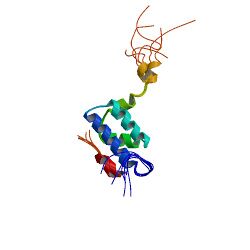Biology:Translocase of the outer membrane
| Mitochondrial import receptor subunit TOM20 | |||||||||
|---|---|---|---|---|---|---|---|---|---|
 | |||||||||
| Identifiers | |||||||||
| Symbol | TOM20_plant | ||||||||
| Pfam | PF06552 | ||||||||
| InterPro | IPR010547 | ||||||||
| TCDB | 3.A.8 | ||||||||
| OPM superfamily | 266 | ||||||||
| OPM protein | 3awr | ||||||||
| Membranome | 170 | ||||||||
| |||||||||
The translocase of the outer membrane (TOM) is a complex of proteins found in the outer mitochondrial membrane of the mitochondria. It allows movement of proteins through this barrier and into the intermembrane space of the mitochondrion. Most of the proteins needed for mitochondrial function are encoded by the nucleus of the cell. The outer membrane of the mitochondrion is impermeable to large molecules greater than 5000 daltons.[1] The TOM works in conjunction with the translocase of the inner membrane (TIM) to translocate proteins into the mitochondrion. Many of the proteins in the TOM complex, such as TOMM22, were first identified in Neurospora crassa and Saccharomyces cerevisiae.[2] Many of the genes encoding these proteins are designated as TOMM (translocase of the outer mitochondrial membrane) complex genes.
The complete mitochondrial protein translocase complex includes at least 19 proteins: several chaperones, four proteins of the outer membrane translocase (Tom) import receptor, five proteins of the Tom channel complex, five proteins of the inner membrane translocase (Tim) and three "motor" proteins.
Protein targeting to the mitochondria
There are various mitochondrial import pathways that exist to facilitate the import of precursor proteins to their destined mitochondrial subcompartments. HSP90 aids the delivery of the mitochondrial preprotein to the TOM complex in an ATP-dependent process.[3] Many precursor proteins (those that are destined for the matrix) contain amino-terminal presequences that carry information required for the targeting of proteins to the mitochondrial matrix[4] These matrix targeting signals generally contain 10-80 amino acid residues that take on the conformation of an amphipathic-α helix[5] and contain one positive and hydrophobic face. Once the precursor reaches the matrix, the presequence is typically cleaved off by the matrix processing peptidase.[6] Proteins targeted to other sub-compartments of the mitochondria such as the intermembrane space and inner mitochondrial membrane, contain internal targeting signals, these signals have an indefinable nature and are inconsistent in their pattern. Proteins targeted to the outer membrane also contain internal targeting signals, not all of which have been identified, and include proteins that take on a β-barrel structure,[7] such as Tom40. Some proteins however, that are targeted to the outer mitochondrial membrane contain a hydrophobic tail domain that anchors the protein to the membrane.[8]
Members of the complex
The translocase of the outer membrane (TOM) forms a complex made of Tom70, Tom22, and Tom20, along with Tom40, Tom7, Tom6, and Tom5. Tom20 and Tom22 are preprotein receptors, which are responsible for recognition of the cleavable presequence possessed by mitochondrial-targeted proteins.[9] Tom70 is also a preprotein receptor and may recognise some cleavable presequence proteins, however it is mainly responsible for the recognition of non-cleavable preproteins and acts as a point for chaperone binding.[6][10] Tom22 is anchored to the outer membrane by a single transmembrane segment and also plays a role in stabilizing the TOM complex.[11] Tom40 is the core element of the translocase complex and complexes with Tom22 with a mass of approximately 350 kilodaltons.[12] It forms the central protein-conducting channel with a diameter of approximately 2.5 nm.[12] The human Tom22 is approximately 15.5 kilodaltons and complexes with Tom20.[13] The N-terminal end of Tom22 extends into the cytosol and is involved in preprotein binding.[13]
Human proteins
See also
References
- ↑ Alberts, Bruce; Alexander Johnson; Julian Lewis; Martin Raff; Keith Roberts; Peter Walter (1994). Molecular Biology of the Cell. New York: Garland Publishing Inc.. ISBN 978-0-8153-3218-3. https://archive.org/details/molecularbiology00albe.
- ↑ "A human homolog of the mitochondrial protein import receptor Mom19 can assemble with the yeast mitochondrial receptor complex". FEBS Lett. 375 (3): 307–10. 1996. doi:10.1016/0014-5793(95)01229-8. PMID 7498524.
- ↑ "Dissection of the mitochondrial import and assembly pathway for human Tom40". J Biol Chem 280 (12): 11535–43. March 2005. doi:10.1074/jbc.M413816200. PMID 15644312.
- ↑ "Tom20 recognizes mitochondrial presequences through dynamic equilibrium among multiple bound states". EMBO J. 26 (22): 4777–87. November 2007. doi:10.1038/sj.emboj.7601888. PMID 17948058.
- ↑ "Membrane protein import in yeast mitochondria". Biochem. Soc. Trans. 28 (4): 495–9. 2000. doi:10.1042/0300-5127:0280495. PMID 10961947.
- ↑ Jump up to: 6.0 6.1 "Molecular chaperones Hsp90 and Hsp70 deliver preproteins to the mitochondrial import receptor Tom70". Cell 112 (1): 41–50. January 2003. doi:10.1016/S0092-8674(02)01250-3. PMID 12526792.
- ↑ "Multiple pathways for sorting mitochondrial precursor proteins". EMBO Rep. 9 (1): 42–9. January 2008. doi:10.1038/sj.embor.7401126. PMID 18174896.
- ↑ "How membrane proteins travel across the mitochondrial intermembrane space". Trends Biochem. Sci. 24 (11): 428–32. November 1999. doi:10.1016/S0968-0004(99)01462-0. PMID 10542408.
- ↑ "Functional staging of ADP/ATP carrier translocation across the outer mitochondrial membrane". J. Biol. Chem. 274 (29): 20619–27. July 1999. doi:10.1074/jbc.274.29.20619. PMID 10400693.
- ↑ "Reinvestigation of the requirement of cytosolic ATP for mitochondrial protein import". J. Biol. Chem. 279 (19): 19464–70. May 2004. doi:10.1074/jbc.M401291200. PMID 15001571.
- ↑ "Transport of the ADP/ATP carrier of mitochondria from the TOM complex to the TIM22.54 complex". EMBO J. 18 (12): 3214–21. June 1999. doi:10.1093/emboj/18.12.3214. PMID 10369662.
- ↑ Jump up to: 12.0 12.1 "Tom40, the Pore-Forming Component of the Protein-Conducting Tom Channel in the Outer Membrane of Mitochondria". J. Cell Biol. 153 (6): 1151–60. 2001. doi:10.1083/jcb.153.6.1151. PMID 11402060.
- ↑ Jump up to: 13.0 13.1 "Identification and Functional Analysis of Human Tom22 for Protein Import into Mitochondria". Mol Cell Biol 20 (19): 7205–13. 2000. doi:10.1128/MCB.20.19.7205-7213.2000. PMID 10982837.
 |

